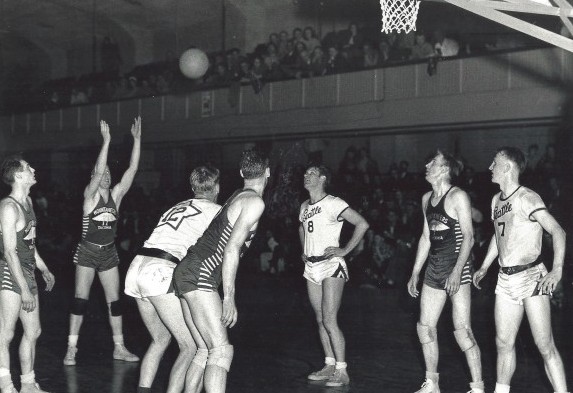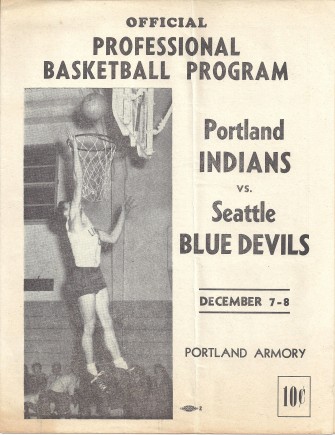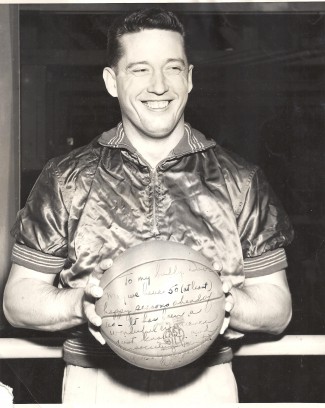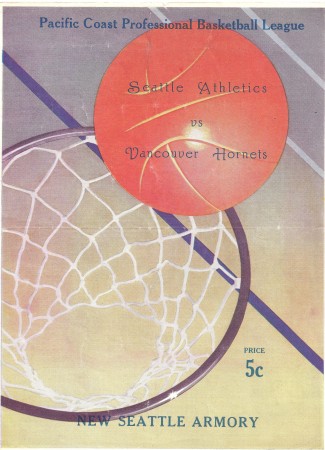
Pre-dating the Seattle Supersonics by 20 years, the little-known Seattle Blue Devils (1946-47) and Seattle Athletics (1947-48) were the city’s first professional basketball teams. Both were members of the Pacific Coast Professional Basketball League, which featured franchises from the Pacific Northwest states and Canada.

The 1946-47 PCPBL lineup included seven franchises (listed here by final league standings) — the Portland Indians (33-10), Bellingham Fircrests (26-12), Vancouver Hornets (24-14), Seattle Blue Devils (18-19), Salem Trailblazers (8-21), Yakima Ramblers (8-25) and Spokane Orphans (1-17).
Salem, Yakima and Spokane failed to last the 1946-47 season, and were dropped from the league.
For 1947-48, the “Pro Coast League,” as the PCPBL was also called, featured the Seattle Athletics (nee Blue Devils), Bellingham Fircrests, Tacoma Mountaineers, Vancouver Hornets, Astoria Royal Chinooks and Portland Indians. Seattle won the season’s first half with a 22-10 record, while Bellingham won the second half with a 14-7 mark.
Ray Clark, a Portland hotel magnate, launched the Pacific Coast Professional Basketball Association and spent, according to the Association for Professional Basketball Research, “freely” trying to establish the league. He even had plans to create a Southern Division, identifying Oakland, San Jose, San Francisco, Stockton, Sacramento, Redding, CA., and Long Beach, CA., as potential franchise cities.
Clark’s vision went unrealized. According to the APBR, only Bellingham and Vancouver were moderately successful at the gate, and the Seattle and Tacoma franchises were disappointments. With most PCPBL teams averaging fewer than 1,500 fans per game, the league founder decided to close the operation after its two-year run.
While it lasted, the bulk of PCPBL rosters were made up of former Pacific Coast Conference (Northern Division) collegians, plus a few high-school standouts. Almost all of the coaches were player/coaches.
The PCPBA showcased several notable players, among them:
- Al Brightman: The future head basketball coach at Seattle University (he

Al Brightman served as player/coach of the Seattle Athletics in 1947-48. / David Eskenazi Collection coached the famous O’Brien twins) joined the Athletics as their player-coach for the 1947-48 season, one year after averaging 9.8 points per game for the Boston Celtics. He became Seattle’s leading scorer and the Athletics’ only member of the All-League team.
- Gale Bishop: A former star at Washington State University, Bishop averaged 19.8 points a game (tops in the league) for Bellingham in 1946-47, and was the league’s leading scorer in 1947-48 before a hand injury ended his season. Bishop set the single-game PCPBL scoring record with 41 points against Portland on Jan. 4, 1948 (later eclipsed). After the collapse of the PCPBL, he played the 1947-48 season with the Philadelphia Warriors, averaging 8.3 points per game.
- Marv Harshman: The future coach at Pacific Lutheran, Washington State and Washington, and a future Basketball Hall of Fame inductee, played for the Tacoma Mountaineers in 1947-48.
-

Game Program Cover / David Eskenazi Collection Wally Leask: A guard for the UW in (1941-43), Leask played for both the Blue Devils and Athletics.
- Slim Wintermute: Served as player/coach of the Portland Indians. Wintermute attended high school in Longview, WA., and joined the Oregon Ducks in 1938. In 1939, Oregon’s “Tall Firs” won the first NCAA Tournament, and Wintermute was an All-American.
PARTIAL ROSTERS
Seattle Blue Devils (1946-47): Norm Dalthorp, Al Maul, Glavin, “Sig” Sigurdson, Parsons, Wally Leask (Washington), Frankie Watson (Gonzaga), Ernie Maskovich, Bill Fleming, John Katica (St. Martins)
Bellingham Fircrests 1946-47: Gale Bishop, Chuck Patterson, Bob Cotton, Bobby Dorr (Washington), Al Akins (Washington), Ray Wark.
Seattle Athletics (1947-48): Wally Leask (Washington), Hal Kottman, Al Brightman, Merlin “Boody” Gilbertson (Washington), Dean White, Frankie Watson (Gonzaga), Norm Dalthorp (Washington), Bill Glavin, Ken Suesens (Sheboygan of NBL), Elmer Gainer.
1947-48: Tacoma Mountaineers: John Katica, Bob Voelker (Washington), Bob Graf, Jack Voelker (Washington), Ernie Endress, Sig Sigurdson, Marv Harshman (Pacific Lutheran), Tom Wark, Tom Cross.
1947-48: Bellingham Fircrests: Al Maul (Bremerton, WA High), Gale Bishop (Washington State), Chuck Patterson, Ray Wark, Bobby Dorr, Cliff Gaffney, Al Akins, Elmer Gainer.
Many of the historic images published on Sportspress Northwest are provided by resident Northwest sports history aficionado, David Eskenazi, who writes The Wayback Machine every Tuesday. Check out Davids Wayback Machine Archive. David can be reached at (206) 441-1900, or at the following e-mailaddress: seattlesportshistory@gmail.com
(Wayback Machine is published every Tuesday as part of Sportspress Northwests package of home-page features collectively titled, The Rotation.)

4 Comments
Lou,
You’re right. Thanks for reading and pointing that out.
Pee Wee Heaps was over-rated when he decided to call a stupid ‘press conference’ to announce he wanted to go to BYU, and is over-rated as a 3rd string QB now.
The LAST thing the Huskies need is a pompous wash-out like Heaps. Kasem Williams made him look great at Skyline, and Heaps has been a disaster at BYU.
BYU would not even compete in the PAC12. Just look at what Utah, their most hated rival, did to them this year, before getting beat-up in the PAC12.
The kid is a double or triple-A QB at best. We don’t need him, and shows NEVER waste a scholarship on him.
Just the fact he wants to transfer because he’s not staring says it all. The kid (and his parents) think he is far better than he is, and mde a huge mistake when they snubbed Sarkisian. In hindsight, thank God we got a great backup in Montana, who fights every practice to play more, than this dweeb who expects to be a star and isn’t even close.
We have two 5-star ‘Elite 24’ QBs who are recruits that want to pay for Sark. We already have 3
One thing in the article is false. Doman (BYU OC) reworked the entire offense in the off season to play to the strengths of Heaps. It included more straight up passing in the pocket. Heaps was taking far more snaps under center than most BYU QB’s have done in the past. Jake’s performance –or lack of– had nothing to do with him not fitting into BYU’s system. He was a local celebrity deemed football’s version of Jimmer. The problem was simply that he didn’t perform on the field. In the first 4 games of this season, he had just one touchdown in each game. His throws missed open receivers, if a defender got within 5 yrds he folded like an old lawn chair, and never won the leadership role. His teammates struggled to see him as their leader especially after referring to them as “those guys” in post game interviews (as if he wasn’t part of them or nothing he did contributed to problems). Whether he was arrogant in person or not, he sure came across that way in public. It was suggested he redshirt next year to mature and grow then still have 2 good years after Nelson graduates. Several other BYU QB’s have done that following their soph. year– ever hear of Jim McMahon?
In my opinion, Jake had been promoted as the QB savior since he was 10 yrs old and never had to compete for the starting position. He was honestly flabbergasted when he was pulled from the Utah St. game which saw Nelson rally for the come from behind win. He didn’t know what to do with the situation and showed no willingness to dig deep and fight to be the starter. Coaches gave him every opportunity in the world to be successful but at some point you have to go with who’s performing on the field and winning the games. Were there mistakes by the young coaching staff? Certainly (like rotating QB’s at first of ’10 season). But when all is said and done– Jake just didn’t bring it to the field. Everyone I’ve heard at BYU wishes him all the best. Maybe the fresh start will be just what he needs to excel and he’ll still land in the NFL– I certainly hope so. Maybe other coaches will get it out of him and he’ll learn to have heart. The talent is certainly there in abundance. Any team picking him up should know there’s work to be done both on and off the field.